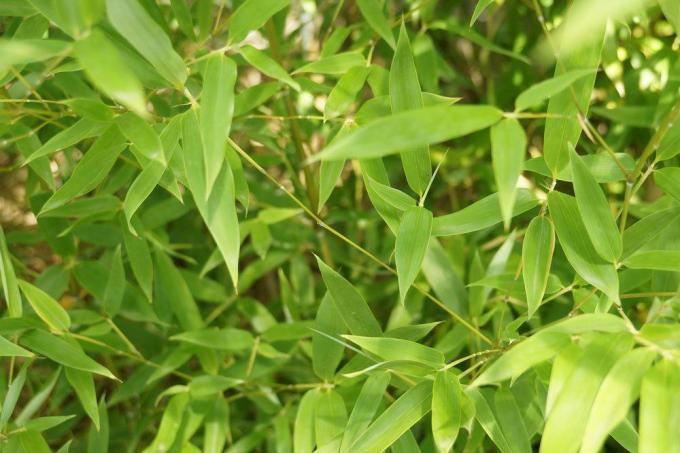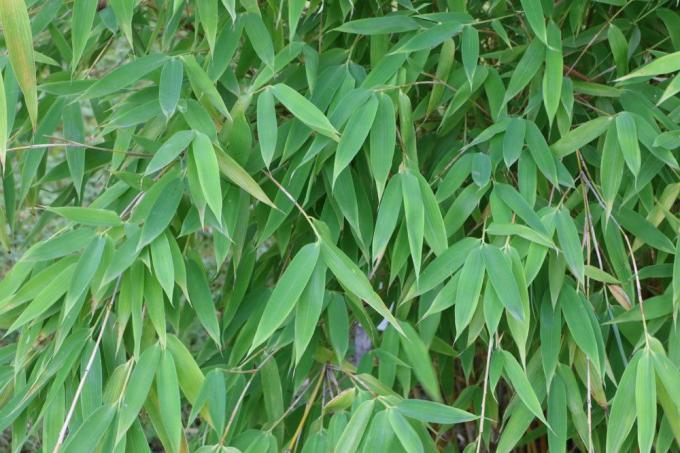
table of contents
- Yellow autumn leaves
- Causes and countermeasures
- Care errors
- Waterlogging is poorly tolerated
- Lack of nutrients leads to chlorosis
- Do not ignore watering
- Pests
The evergreen sweet grass is becoming more and more popular in gardens, not only because of its natural and imposing appearance, but also because of how easy it is to care for. Bamboo is suitable both as a solitary plant for standing alone, as a bamboo hedge, and as a container plant on the balcony or terrace. The plants need a sheltered and warm location for good growth. However, sometimes the beauty of the bamboo can be damaged by the formation of yellow leaves or brown leaf tips. It is then always important to get to the bottom of the yellow color of the leaves in order to prevent further damage to the plant.
Yellow autumn leaves
But watch out, not all yellow discolorations of the leaves ultimately indicate a care error or infestation with pests and diseases. Intensive breeding has resulted in around 1,500 different types of bamboo to date. Some of these cultivars already have yellowish leaves from home, such as Fargusia muriclae "Green Arrows" or Pleioblastus viridistiatus.
In addition, it is also quite normal that this wintergreen plant also has an annual in autumn Change of foliage to renew the foliage. The intensity of the yellowing of the leaves can vary considerably depending on the variety. Yellow leaves in autumn are always a sign that the plants have an adequate supply of nutrients. First the tips of the leaves turn brown and then finally the whole leaf turns yellow.
However, the leaves should now turn yellow outside of the autumn months then caution is always advised. There are other different causes that are responsible for this color change. These should then be explored as quickly as possible.
When deciding on bamboo in the garden, the winter hardiness of the plants must always be taken into account. Not all varieties survive the winter in our region without any problems. This can lead to frostbite, yellow and dead leaves.

tip: Bamboo varieties that are not hardy can simply be moved into a bucket and overwintered in a light and frost-free room or greenhouse.
Causes and countermeasures
Care errors
Waterlogging is poorly tolerated
Like all plants, bamboo is also very sensitive to waterlogging. Yellow leaves can then quickly form. If nothing is done about it, it won't be long and the bamboo will die.
So if waterlogging occurs, action must be taken as soon as possible. There are now various options.
When planting in a tub, the following must be observed:
- Constant control of the water drainage for blockages
- Immediate repotting if there is any damage
- Use of loose, sandy and humus-rich substrate
- Check the roots, remove diseased and rotten parts
- Cover the drainage holes in the bucket with potsherds
- Then fill in a 15 cm high drainage layer made of expanded clay or clay granules
- Cover the drainage layer with fleece
- Then fill in new plant substrate and insert trimmed bamboo
- Pour everything lightly. Normally, healthy leaves will then quickly sprout again.
When planting bamboo in the garden, it is important to remove the soil and lay drainage when waterlogging occurs. To do this, the plants must be taken out of the ground. The roots should dry out slightly. The potting soil is then mixed with gravel and sand to avoid waterlogging again.

tip: So-called hill plantings for bamboo are particularly good in the garden. This is planted slightly higher on a sand-earth mixture.
Lack of nutrients leads to chlorosis
The nutrient supply must never be neglected, even with bamboo planting. Only the correct composition of the required nutrients ensures that these evergreen plants will grow splendidly.
- A lack of nutrients results in a lack of chlorophyll in leaves
- Consequence: yellowing of the leaves, whereby pathways remain green
- Deficiency of iron, magnesium and nitrogen causes chlorosis disease
- One-time pouring with iron fertilizer, for example Fetrilon, provides a remedy
- Usually repetition necessary in the following year
Other causes for the development of chlorosis are also possible, such as:
- Incorrect soil conditions, such as salinisation due to overfertilization
- too high lime content in the soil
fertilization
In order to prevent a lack of nutrients in bamboo, fertilization should be carried out all year round, except in winter during the rest break. The special bamboo fertilizer Toolisan is recommended here.
tip: These are to be calculated precisely when applying fertilizers. Over-fertilization also leads to damage, such as yellowing of the leaves. The only remedy here can then only be a complete earth exchange.
Do not ignore watering
Since the evergreen plants have a lush foliage, watering them all year round is necessary, even in winter. A lack of water usually leads to the leaves curling up, but also tanLeaf tips can be a sign of this here. This process reduces the evaporation area and reduces the natural protection of the plants.
- adequate watering in dry and warm weather and before long periods of frost
- Watering necessary on frost-free days in winter to avoid drying out damage
- Always give water in the early morning or evening during the summer
- less watering of older plants, where roots have already penetrated into deeper regions of the earth
- Young plants during the growth phase need more water
Sometimes there is also the possibility that straight freshly planted bamboo gets brown and yellow leaves. This process is called Plant shock designated. Abundant watering can be helpful here.

tip: Please note that regular watering of the plants also flushes out nutrients. It is therefore important to always intervene in a compensatory manner.
Pests
Usually the bamboo is quite robust against pests and diseases. Nevertheless, it can happen that mealybugs and mealybugs settle under the stalk sheaths of the plants. These lead to brown and yellow leaves. Constant monitoring is therefore necessary.
- Always dispose of sick leaves in household waste
- Shower affected plants with nettle liquid for several days
- Use a mixture of potash soap or acaricide as an alternative
- Abundant watering and the setting up of blue glue boards help as a preventative measure
However, better protection can be provided by a “natural insect police” such as ladybugs, predatory mites, hover flies, wasps, ground beetles or ants. These can be found in a natural cultivation in the garden.



